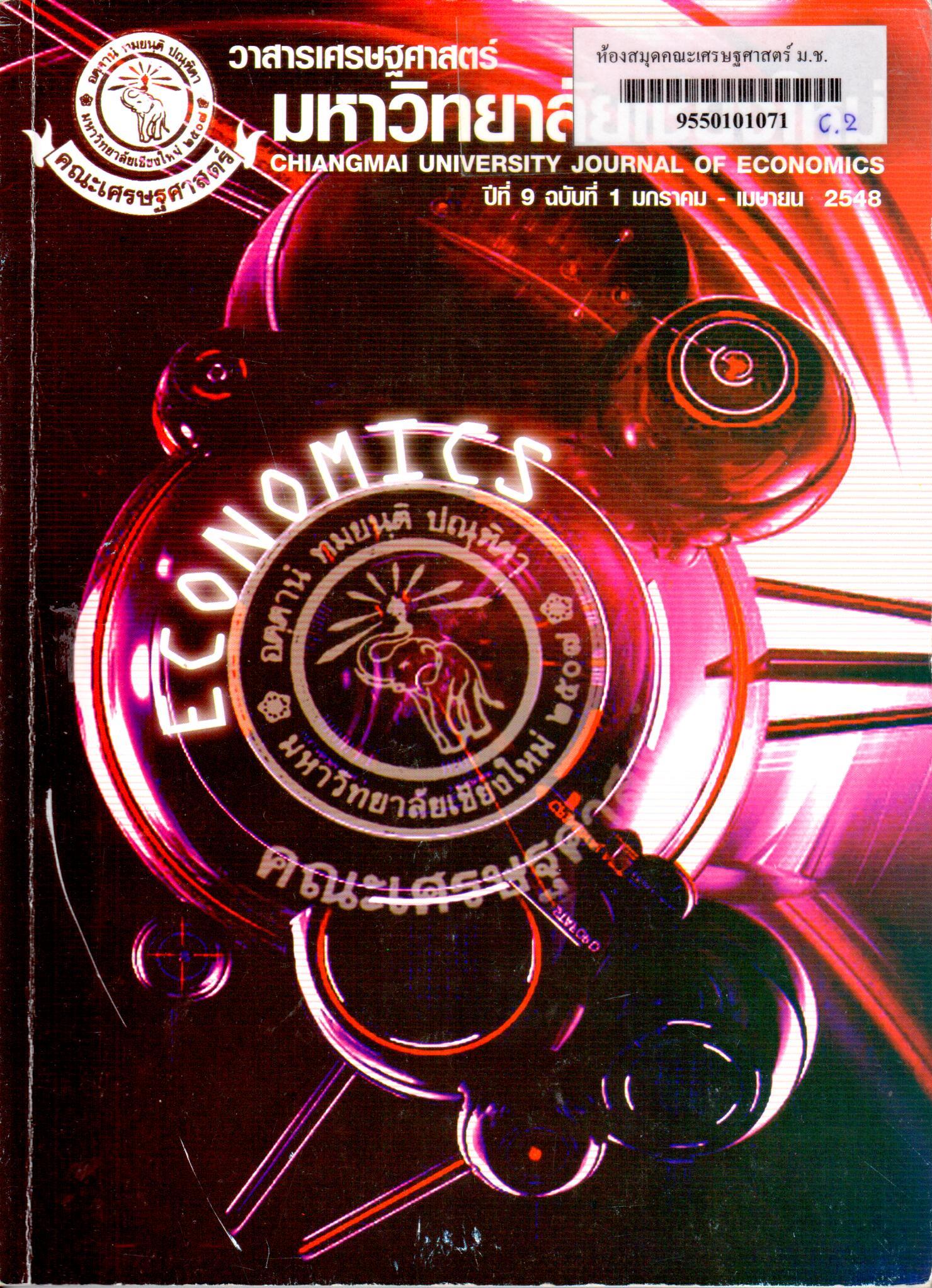การวิเคราะห์ความเสี่ยงและผลตอบแทนของหลักทรัพย์กลุ่มพลังงานในตลาดหลักทรัพย์แห่งประเทศไทยโดยแบบจำลองฟาร์มาและเฟรนซ์
Abstract
บทคัดย่อ
การศึกษาครั้งนี้ มีวัตถุประสงค์ที่จะวิเคราะห์ความเสี่ยงและผลตอบแทนของหลักทรัพย์กลุ่มพลังงานในตลาดหลักทรัพย์แห่งประเทศไทย เพื่อใช้เป็นแนวทางในการประเมินราคาของหลักทรัพย์ โดยทำการศึกษาหลักทรัพย์ในกลุ่มพลังงานจำนวน 11 หลักทรัพย์ ได้แก่ หลักทรัพย์ BAFS, BANPU, BCP, EASTW, EGCOMP, LANNA, PICNI, PTT, PTTEP, RATCH และ SUSCO โดยใช้ข้อมูลราคาปิดของหลักทรัพย์กลุ่มพลังงาน เงินปันผลและใช้อัตราดอกเบี้ยเงินฝากประจำ 12 เดือนของธนาคารพาณิชย์ขนาดใหญ่ 4 ธนาคารมาหาค่าเฉลี่ยเพื่อเป็นตัวแทนของอัตราผลตอบแทนที่ปราศจากความเสี่ยง เริ่มศึกษาตั้งแต่วันที่ 2 กรกฎาคม พ. ศ. 2540 ถึงวันที่ 31 ธันวาคม พ. ศ. 2547 และทำการแบ่งช่วงการศึกษาเป็นระยะสั้น ระยะกลาง และระยะยาว คือแบ่งการศึกษาเป็นรายสัปดาห์ รวม 392 สัปดาห์ รายเดือน รวม 90 เดือน และรายไตรมาส รวม 30 ไตรมาส โดยใช้แบบจำลองฟาร์มาและเฟรนช์ (Fama French three factor asset pricing model) และวิธีการถดถอยแบบสลับเปลี่ยน (switching regression method) ในการแบ่งเป็นภาวะหลักทรัพย์ขาขึ้นและขาลง
ขั้นแรก นำข้อมูลอนุกรมเวลาที่ทำการศึกษามาทดสอบ unit root ด้วยวิธี Augmented Dickey - Fuller test และPhillips - Perron test พบว่ามีหลักทรัพย์จำนวน 9 หลักทรัพย์ที่นิ่งในระดับ 0 (integration of order 0) ได้แก่ หลักทรัพย์ BANPU, BCP, EASTW, EGCOMP, LANNA, PICNI,PTT, PTTEP และ SUSCO ซึ่งการทดสอบ unit root ด้วยวิธี philips - Perron test จะให้ค่านัยสำคัญทางสถิติที่ดีกว่าการทดสอบด้วยวิธี Augmented Dickey - Fuller test
จากนั้นการประมาณค่าโดยวิธีกำลังสองน้อยที่สุด โดยใช้แบบจำลองฟาร์มาและเฟรนช์ สำหรับหลักทรัพย์แต่ละชนิดเพื่อวิเคราะห์ความสัมพันธ์ระหว่างอัตราผลตอบแทนของตลาดหลักทรัพย์ (Rm-Rf) ขนาดของธุรกิจ (SMB) และอัตราส่วนมูลค่าหลักทรัพย์ตามบัญชีต่อราคาตลาด (HML) ที่มีผลต่ออัตราผลตอบแทนของหลักทรัพย์กลุ่มพลังงาน พบว่า ในรายสัปดาห์ ค่า R2 จากการศึกษาทั้งหมด 9 หลักทรัพย์อยู่ในช่วง 0.503 ถึง 0.992 ในรายเดือน ค่า R2 ของทั้ง 9 หลักทรัพย์อยู่ในช่วง 0.390 ถึง 0.990 และในไตรมาส ค่า R2 ของทั้ง 9 หลักทรัพย์ อยู่ในช่วง 0.710 ถึง 0.999 โดยช่วงเวลาที่เหมาะสมในการประมาณค่าความเสี่ยงและผลตอบแทนของหลักทรัพย์กลุ่มพลังงาน โดยภาพรวมคือระยะยาวหรือการศึกษาโดยใช้ข้อมูลรายไตรมาส เพราะมีหลักทรัพย์จำนวน 7 หลักทรัพย์จากหลักทรัพย์ในกลุ่มพลังงานทั้งหมด 9 หลักทรัพย์ (BANPU, BCP, EASTW, EGCOMP, LANNA, PTT และ PTTEP) สามารถให้ค่าเฉลี่ยของความคลาดเคลื่อนกำลังสองน้อยที่สุด และเมื่อพิจารณาจากค่า R2 ที่ทำให้การวิเคราะห์ในรายไตรมาสก็ให้ค่า R2 สูงเมื่อเปรียบเทียบกับรายสัปดาห์และรายเดือน
ขั้นต่อมาทำการศึกษาการคาดคะเนความเสี่ยงของหลักทรัพย์กลุ่มพลังงานในภาวะหลักทรัพย์ขาขึ้นและภาวะหลักทรัพย์ขาลง เพื่อดูความมีประสิทธิภาพในการกำหนดเงื่อนไขตามแบบวิธีการถดถอยแบบสลับเปลี่ยน พบว่า ความเสี่ยงในภาวะหลักทรัพย์ขาขึ้นและความเสี่ยง ในภาวะหลักทรัพย์ขาลงมีความแตกต่างกันอย่างมีนัยสำคัญในทุกหลักทรัพย์ที่ทำการศึกษาในกลุ่มพลังงาน จำนวน 9 หลักทรัพย์ทั้งการวิเคราะห์ในรายสัปดาห์ รายเดือนและรายไตรมาส
ขั้นสุดท้าย คือการเปรียบเทียบค่าความเสี่ยงของหลักทรัพย์จากแบบจำลองฟาร์มาและ
เฟรนช์โดยภาพรวมและการแบ่งเป็นภาวะตลาดหลักทรัพย์ขาขึ้นและภาวะหลักทรัพย์ขาลง โดยใช้วิธีการถดถอยแบบสลับเปลี่ยน พบว่า ในภาวะหลักทรัพย์ขาขึ้นหลักทรัพย์กลุ่มพลังงานส่วนใหญ่มีค่าความเสี่ยงมากกว่าหนึ่ง (>1) แสดงว่าหลักทรัพย์นั้นมีการเปลี่ยนแปลงของอัตราผลตอบแทนมากกว่าการเปลี่ยนแปลงของอัตราผลตอบแทนของตลาด โดยผู้ลงทุนยอมรับความเสี่ยงที่สูงในการลงทุนในหลักทรัพย์กลุ่มพลังงานเพื่อแลกกับผลกำไรที่คาดว่าจะได้มากเช่นกัน แต่ในภาวะหลักทรัพย์ขาลงหลักทรัพย์กลุ่มพลังงานส่วนใหญ่มีค่าความเสี่ยงน้อยกว่าหนึ่ง (<1) แสดงว่าหลักทรัพย์นั้นมีการเปลี่ยนแปลงของอัตราผลตอบแทนน้อยกว่าการเปลี่ยนแปลงของอัตราผลตอบแทนของตลาด แต่เมื่อดูความเสี่ยงของหลักทรัพย์กลุ่มพลังงานในภาพรวม ไม่สามารถอธิบายได้อย่างชัดเจนว่าค่าความเสี่ยงมีค่ามากกว่าหรือน้อยกว่า 1 ทั้งข้อมูลรายสัปดาห์ รายเดือนและรายไตรมาส ทั้งนี้ นักลงทุนควรดูข้อมูลพื้นฐานของแต่ละหลักทรัพย์ประกอบด้วยเพื่อให้การลงทุนเกิดประสิทธิภาพและได้ผลตอบแทนที่คาดหวังสูงสุด อันจะส่งผลต่อความเจริญเติบโตของตลาดหลักทรัพย์ไทยต่อไป
Abstract
This study aimed to analyze risk and return in the Energy Sector in the stock Exchange of Thailand and to use as a guideline in estimate security prices. The closed prices of eleven securities in the Energy Sector, namely BAFS, BANPU, BCP, EASTW, EGCOMP, LANNA, PICNI, PTT, PTTEP, RAYCH, and SUSCO, were selected for the analysis. Dividend and the average of 12-months deposit interest rate from 4 national leading commercial banks was used to represent as the return of risk-free rate. The data starting from July 2, 1997 to December 31, 2004 had been conducted by using 392 weekly data, 90 monthly data, and 30 quarterly data which represent in the short term, the intermediate term, and the long term, respectively. This study also employed the Fama French Three Factors Asset Pricing Model and the Swithing Regression Method for the analysis.
The first step, the Unit Root Test by the Augmented Dickey – Fuller Test and the Phillips – Perron Test were utilized to test the stationary of the time-series data. The results showed that nine securities namely BANPU, BCP, EASTW, EGCOMP, LANNA, PICNI, PTT, PTTEP, RAYCH, and SUSCO were stationary at level 0. In addition, the Phillips – Perron Test had the better significant statistic than the Augmented Dickey – Fuller Test.
Then, the Ordinary Least Square of the Fama French Three Factors Asset Pricing Model was used to analyze the relationship between the rate of return of the stock market (Rm- Rf), Size (SMB) and Book to Market (HML) with the rate of return of the Energy Sector. The empirical results indicated that the weekly R2 value of nine securities ranged between 0.503 – 0.992. The monthly R2 value of nine securities ranged between 0.390 – 0.990, and the quarterly R2 value of nine.
Securities ranged between 0.710 – 0.999. For the optimal time period to estimate risk and return of Energy Sector was the long term or the quarterly data because saven securities of nine (BANPU, BCP, EASTW, EGCOMP, LANNA, PTT, PTTEP) had the least Mean Square Error and had a higher quarterly R2 value compared with the weekly and monthly.
Next, the Switching Regression Method was employed to estimate the risk of nine Energy Sector’s securities for the up and down regime. The results indicated that risk of all securities were significantly different in he two regimes for all of weekly, monthly and quarterly.
The last step involved the comparison the risk value () of the Fama French Three Factors Asset Pricing Model and the switching Regression Method that separated to the up and down regime. The results showed that the most securities of the up regime with the positive rate of return had the risk value greater than 1 (> 1), implying that the changes in the return of securities were more than the changes in the return of the whole market. Thus, the investors tended to accept the risk of return in the order to substitute with the more expected profits. The most securities of the down regime with the negative rate of return had the risk value less than 1 ( < 1), implying that the changes in the return of securities were less than the changes in the return of the whole market. For the total view, the study could not clearly explain that the risk value had greater or less than 1 for all of weekly, monthly and quarterly data. Therefore, the investors should take the fundamental information of each security in order to decide which is the most efficient investment with the most capital gain leading to the growth of Stock Exchange of Thailand.
Downloads
Issue
Section
License
All opinions and contents in the CMJE are the responsibility of the author(s). Chiang Mai University Journal of Economics reserves the copyright for all published materials. Papers may not be reproduced in any form without the written permission from Chiang Mai University Journal of Economics.
ข้อคิดเห็นที่ปรากฏและแสดงในเนื้อหาบทความต่างๆในวารสารเศรษฐศาสตร์มหาวิทยาลัยเชียงใหม่ ถือเป็นความเห็นและความรับผิดชอบโดยตรงของผู้เขียนบทความนั้นๆ มิใช่เป็นความเห็นและความรับผิดชอบใดๆของวารสารเศรษฐศาสตร์ มหาวิทยาลัยเชียงใหม่
บทความ เนื้อหา และข้อมูล ฯลฯ ในวารสารเศรษฐศาสตร์มหาวิทยาลัยเชียงใหม่ ถือเป็นลิขสิทธิ์เฉพาะของคณะเศรษฐศาสตร์มหาวิทยาลัยเชียงใหม่ หากบุคคลหรือหน่วยงานใดต้องการนำทั้งหมดหรือส่วนหนึ่งส่วนใดไปเผยแพร่ต่อหรือเพื่อกระทำการใดๆ จะต้องได้รับอนุญาตเป็นลายลักษณ์อักษร จากวารสารเศรษฐศาสตร์ มหาวิทยาลัยเชียงใหม่






